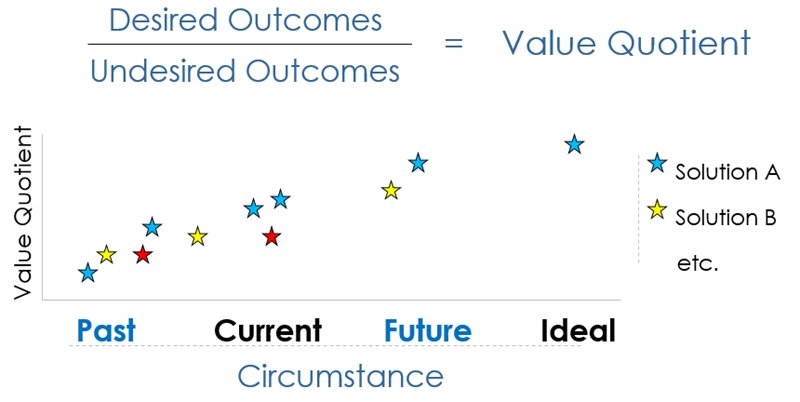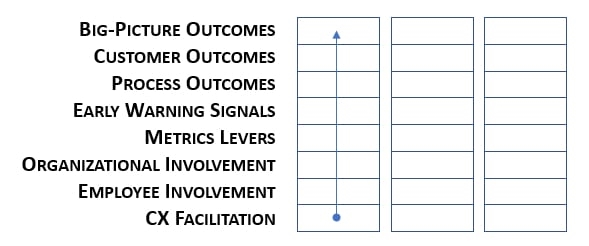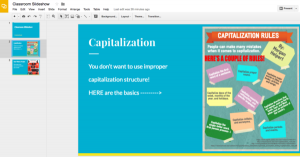 “Customer-centered management is straightforward business sense,” declared the first article1 in this six-part CEO’s Guide to Growth series. Indeed, this declaration is reinforced by the new Principles of Corporate Governance, overhauled by Business Roundtable in August 2019.2
“Customer-centered management is straightforward business sense,” declared the first article1 in this six-part CEO’s Guide to Growth series. Indeed, this declaration is reinforced by the new Principles of Corporate Governance, overhauled by Business Roundtable in August 2019.2
Modern corporate governance replaces shareholder primacy with balanced attention among five vital stakeholders: customers, employees, suppliers, communities and shareholders.
“CEOs work to generate profits and return value to shareholders, but the best-run companies do more,” said Tricia Griffith, President and CEO of Progressive Corporation. “They put the customer first and invest in their employees and communities. In the end, it’s the most promising way to build long-term value.”2
Standout firms outperformed the S&P 500 by an 8-to-1 ratio in a study of companies that aligned the interests of all stakeholder groups, cited in the first article of this series.1
A precursor to progress in profits and top-line proceeds is customers’ predisposition toward your brand. Customers are the source of budgets, salaries and dividends. Accordingly, customer-centered management is a fitting description of the new Principles of Corporate Governance. Customers are the source of funding that’s needed to satisfy the needs of the other four stakeholders. A mis-match between your core growth customers and how you select and manage the other four stakeholders will short-circuit growth for all.
New Key Performance Indicators
What is your enterprise’s capability in aligning these five stakeholders?
How should Wall Street analysts and the media shift their assessments of your enterprise performance in accordance with the shift in Principles of Corporate Governance?
These questions are answered in this CEO’s Guide to Growth series. New key performance indicators (KPIs) are needed to assess:
- Ease-of-Doing-Business from the viewpoint of customers and suppliers.
- Ease-of-Work from the viewpoint of employees.
- These two KPIs are precursors to value realized by your communities and shareholders.
As your roadmap and indices for customer-centered management capability, let’s review the alternative angles on Ease-of-Doing-Business and Ease-of-Work provided by this article series:
Ease of Doing Business
This is a spin-off of the World Bank’s Ease-of-Doing-Business Index3. The World Bank quantifies the extent to which business activity is enhanced or constrained by each country’s regulations. One spin-off discussed recently in Harvard Business Review is countries’ Ease-of-Doing-Digital-Business.4
For your spin-off, Ease-of-Doing-Business for the new Principles of Corporate Governance quantifies the extent to which customers are enhanced or constrained by your enterprise.
Inspiration for this KPI is the customer experience value quotient:5

For customers, the path of least resistance wins. “Ease” may mean effortlessness in some customers’ circumstances, but most importantly, it means freedom from worry.
Customers constantly juggle a lot with many entities. Pleasant surprises along customers’ path with you are nice-to-haves. But what they really want is predictability and reliability. They want delivery of your value proposition without negative surprises: problems, waiting, extra steps, escalations, etc.
Shareholder primacy has jeopardized predictability and reliability to-date. Shortcuts in the quest for quarterly gains have ratcheted up silos and waste. As such, “customer experience management” today is generally a set of Band-Aids® — fingers in the dyke to slow the flow of customer churn. Differentiate your business by near-100% performance among your core growth customers, as a start, in predictability and reliability.
The stock price for customer experience (CX) leaders grew 34%, in comparison to 5% for CX laggards and 20% for the S&P 500 during the same time period.6 However, for the past three years, best performers in customer experience top-out below 75 on a 100-point index.7
Plateaus indicate that business-as-usual is far from sufficient: tactical customer experience management falls short of enterprise needs for differentiation and growth. Advice from the fourth part of this series, CEO’s Guide to Growth through Customer Experience Momentum:
- Shift from customer touch-point focus to operationalizing customer experience enterprise-wide. (prevent issue recurrence)
- Replace narrow, remedial emphasis with strategic, proactive emphasis. (prevent issue occurrence)
The shift in corporate governance highlights operational excellence:
1. “Customer experience annuities” were introduced in the fifth part of this series, CEO’s Guide to Growth through Customer Experience Action:
Preventing recurrence of perpetual issues experienced by customers is the heart of customer experience management. This is the source of customer experience annuities, which free-up resources that were previously dedicated forever to the equivalent of ‘Band-Aids®’, and re-allocate those resources to higher-value opportunities.
2. Further growth in revenue and profitability is achieved through enterprise-wide anticipation of customers’ reactions:
Preventing occurrence of customer issues is known as ’embedding customer-centricity DNA’ throughout your company’s culture. Thorough understanding of customers’ expectations and realities is a prerequisite to preventing issues that bother customers. This understanding must permeate all disciplines’ decision-making and handoffs across your enterprise.
3. Sustainable revenue growth is stimulated by customer experience innovation. An 8X revenue advantage from customer-inspired innovations versus internally-inspired innovations was discovered in an MIT study reviewing revenue growth from 1,193 successful innovations across 9 industries over a 5-year period.8
Ease-of-Doing-Business is the lifeblood of positive word-of-mouth for market share expansion and customer lifetime value expansion.
Ease of Work
Customer experience and employee experience go hand-in-hand. Simplifying work within the context of customers’ needs reduces lost opportunities for all parties.
“Customer experience insurance” is created by minimizing the likelihood of employee decisions that result in costly reputation fiascos.
HCL’s CEO said: “Our biggest problem with the organization structure was that it did not support the people in what we call the value zone: the place where value is truly created for customers.”9
“In a services company in a knowledge economy, this zone lays in the interface between the customer and the employee. . . .”9
“So, to shift our focus to the value zone, we turned the organization upside down and made management and managers, including those in enabling functions (such as human resources, finance, training, and others), accountable to those who create value.”9
The shift in corporate governance highlights alignment:
Surprisingly, the major glitch for agility and alignment is lack of clear understanding about how major priorities and objectives fit together, according to extensive research conducted by Donald Sull from MIT Sloan School of Management:10
Typically, half of the C-suite struggles with connecting the dots accurately, with further dilution to less than a third of senior executives’ direct reports and just 16% of customer-facing supervisors and team leaders successfully identifying the relationships between corporate priorities and objectives.
CEOs can increase their organization’s clear understanding of how major priorities and objectives fit together through 1) prioritization clarity, 2) core customers clarity, 3) customer management clarity, and 4) customer excellence maturity clarity, as explained in the second part of this series, CEO’s Guide to Growth through Customer Experience Alignment.
Growth subsides eventually when it is enticed. It’s a never-ending hamster-wheel to entice engagement. Gaps between what’s promised and what’s delivered are the main reason why we invest in customer engagement programs — remedial investments. These gaps erode trust.
Growth endures when it is earned through trust. Organic customer engagement is reciprocated to the extent that employee engagement improves customers’ well-being, as explained in the third part of this series, CEO’s Guide to Growth through Customer Experience Engagement:
Engaging employees in customer experience goes well beyond customer-facing roles. Customer touch-points are only as successful as the rest of the enterprise empowers them to be. Every discipline across your company has a ripple-effect on customer experience, like concentric circles rippling from a pebble thrown in a pond.
Self-reporting team recognition is quite powerful in evolving customer-centric culture. Cost savings, productivity improvements, and higher morale were enjoyed throughout Applied Materials and across the customer base. Examples of achievements that grew customer trust:11
- 16X reduction in customers’ time for service
- Exceeded customer expectations by 75%
- 10X increase in customer productivity
- 10X reduction in lead time from 5 days to 5 hours
- 6X improvement in trouble-shooting cycle time
- $ 1M savings monthly to the customer
- 80% reduction in customer engineers’ learning cycle time
- 75% reduction in customer-reported bugs/issues
 Focus primarily on what teams can control in their daily work flow (labeled in this diagram as “early warning signals”). Customer experience managers should track their own progress in driving the metrics preceding this: facilitation, involvement, levers. Accurate customer loyalty correlation analysis (aka key driver analysis), Pareto analysis of related customer comments, and root cause analysis (aka 5 why’s) will zero-in where teams should focus.
Focus primarily on what teams can control in their daily work flow (labeled in this diagram as “early warning signals”). Customer experience managers should track their own progress in driving the metrics preceding this: facilitation, involvement, levers. Accurate customer loyalty correlation analysis (aka key driver analysis), Pareto analysis of related customer comments, and root cause analysis (aka 5 why’s) will zero-in where teams should focus.
Accordingly, you can have confidence that progress at the team level will naturally yield corresponding progress in subsequent levels upward to the big-picture metrics of wallet share, market share, revenue growth and earnings growth.
Accelerating & Sustaining Growth
Shareholder primacy is old-fashioned thinking that has eroded trust and profitability. Follow the money. Customers are funding everything your company does, including repayment to lenders and investors. Corporate strategy is customer experience strategy, and vice versa.
- Customer experience is customers’ realities compared to their expectations.
- Sustained-growth customer experience management is alignment of the company to customers.
Customer-centered capability for your enterprise means you’re setup for success by establishing intentional customer experience as your enterprise-wide north star. This goes beyond a Net Promoter Score® score. It’s about ease of work and ease of doing business, in accordance with your core-growth customers’ needs.
Customer-centered capability embeds this north star into your enterprise’s DNA. It unifies your senior leadership team. It fosters a collaborative spirit that minimizes or bridges silos. It becomes a magnetic force for top talent, productivity and value growth for both customers and shareholders.
References:
1CEO’s Guide to Growth through Customer-Centered Management, CustomerThink, Lynn Hunsaker, January 16, 2019.
2Business Roundtable Redefines the Purpose of a Corporation to Promote ‘An Economy That Serves All Americans’, Business Roundtable, August 19, 2019.
3Doing Business 2020: Sustaining the Pace of Reforms, The World Bank, October 24, 2019.
4Ranking 42 Countries by Ease of Doing Digital Business, Harvard Business Review, Bhaskar Chakravorti and Ravi Shankar Chaturvedi, September 5, 2019.
5What’s Your Customer Experience Value Quotient?, ClearAction.com, Lynn Hunsaker.
6Does CX Quality Affect Stock Performance? Yes, But . . . , Forrester, Rick Parrish, 2018.
7The US Customer Experience Index 2019: Some Small Gains, Widespread Stagnation, No Real Leaders, Forrester, Rick Parrish, 2019.
8The Things Customers Can Do Better Than You, Harvard Business Review, Bill Lee, April 5, 2012.
9Customers First, or Employees First?, ClearAction.com, Lynn Hunsaker.
10Why Strategy Execution Unravels and What to Do About It, Harvard Business Review, Donald Sull et al, March 2015.
11CEO’s Guide to Growth through Customer Experience Engagement, CustomerThink, Lynn Hunsaker, May 7, 2019.
Image licensed to ClearAction Continuum by Shutterstock.
Business & Finance Articles on Business 2 Community
(26)
Report Post







